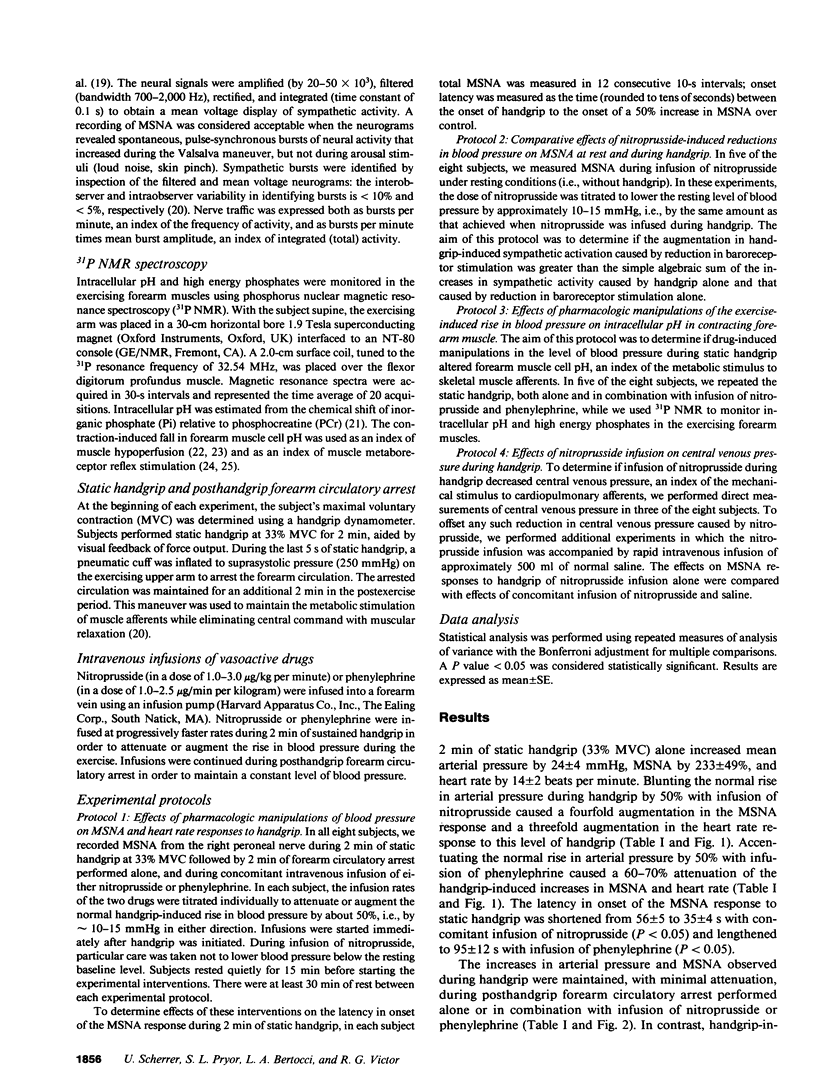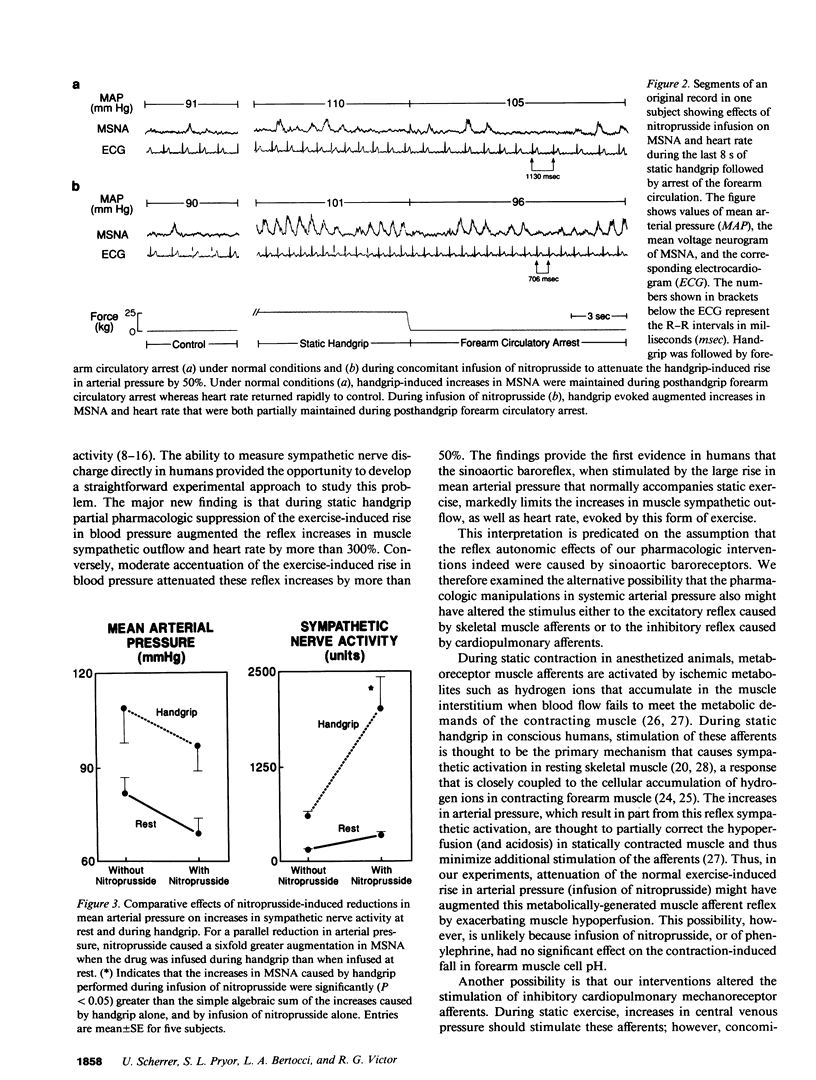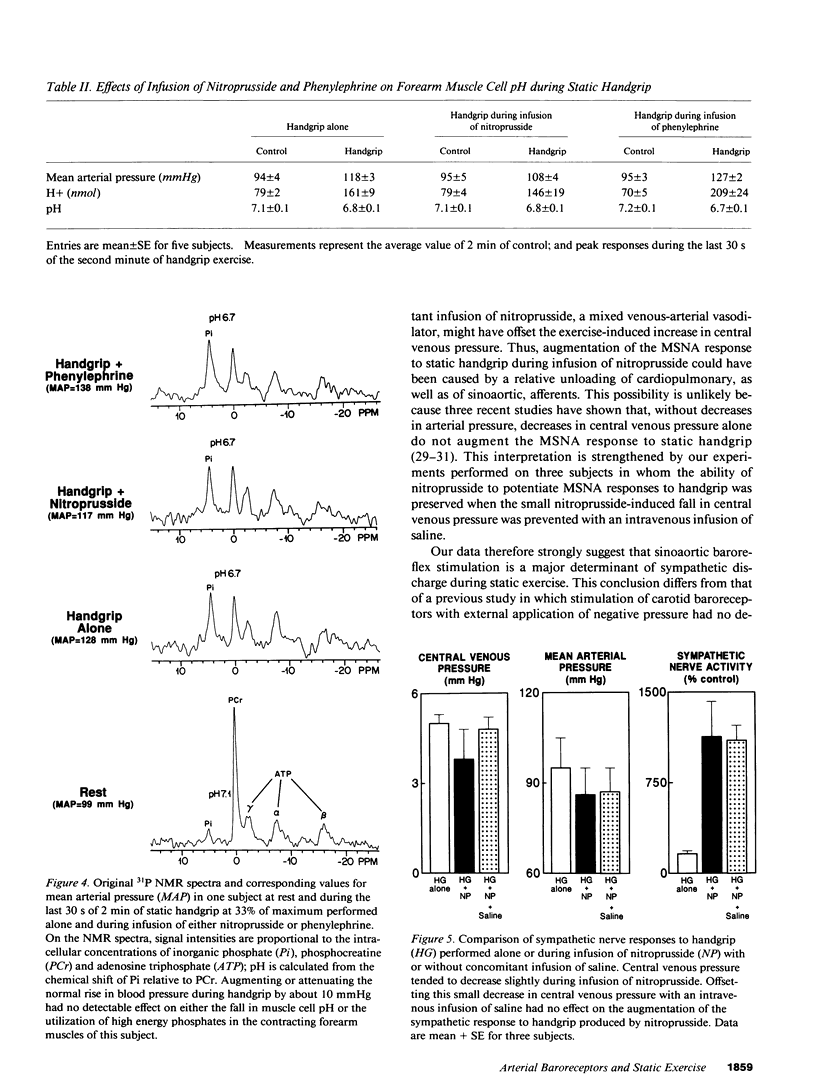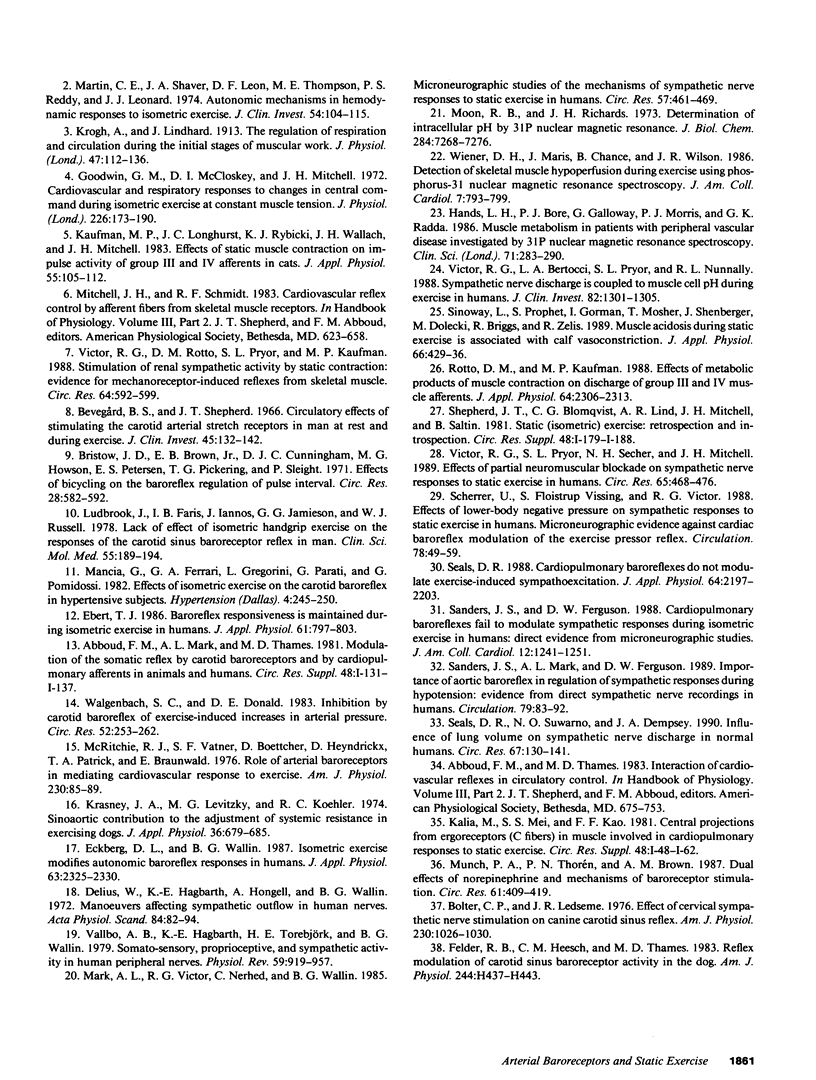Abstract
Static muscle contraction activates metabolically sensitive muscle afferents that reflexively increase sympathetic nerve activity and arterial pressure. To determine if this contraction-induced reflex is modulated by the sinoaortic baroreflex, we performed microelectrode recordings of sympathetic nerve activity to resting leg muscle during static handgrip in humans while attempting to clamp the level of baroreflex stimulation by controlling the exercise-induced rise in blood pressure with pharmacologic agents. The principal new finding is that partial pharmacologic suppression of the rise in blood pressure during static handgrip (nitroprusside infusion) augmented the exercise-induced increases in heart rate and sympathetic activity by greater than 300%. Pharmacologic accentuation of the exercise-induced rise in blood pressure (phenylephrine infusion) attenuated these reflex increases by greater than 50%. In contrast, these pharmacologic manipulations in arterial pressure had little or no effect on: (a) forearm muscle cell pH, an index of the metabolic stimulus to skeletal muscle afferents; or (b) central venous pressure, an index of the mechanical stimulus to cardiopulmonary afferents. We conclude that in humans the sinoaortic baroreflex is much more effective than previously thought in buffering the reflex sympathetic activation caused by static muscle contraction.
Full text
PDF






Selected References
These references are in PubMed. This may not be the complete list of references from this article.
- Bevegård B. S., Shepherd J. T. Circulatory effects of stimulating the carotid arterial stretch receptors in man at rest and during exercise. J Clin Invest. 1966 Jan;45(1):132–142. doi: 10.1172/JCI105317. [DOI] [PMC free article] [PubMed] [Google Scholar]
- Bolter C. P., Ledsome J. R. Effect of cervical sympathetic nerve stimulation on canine carotid sinus reflex. Am J Physiol. 1976 Apr;230(4):1026–1030. doi: 10.1152/ajplegacy.1976.230.4.1026. [DOI] [PubMed] [Google Scholar]
- Delius W., Hagbarth K. E., Hongell A., Wallin B. G. Manoeuvres affecting sympathetic outflow in human muscle nerves. Acta Physiol Scand. 1972 Jan;84(1):82–94. doi: 10.1111/j.1748-1716.1972.tb05157.x. [DOI] [PubMed] [Google Scholar]
- Ebert T. J. Baroreflex responsiveness is maintained during isometric exercise in humans. J Appl Physiol (1985) 1986 Aug;61(2):797–803. doi: 10.1152/jappl.1986.61.2.797. [DOI] [PubMed] [Google Scholar]
- Eckberg D. L., Wallin B. G. Isometric exercise modifies autonomic baroreflex responses in humans. J Appl Physiol (1985) 1987 Dec;63(6):2325–2330. doi: 10.1152/jappl.1987.63.6.2325. [DOI] [PubMed] [Google Scholar]
- Felder R. B., Heesch C. M., Thames M. D. Reflex modulation of carotid sinus baroreceptor activity in the dog. Am J Physiol. 1983 Mar;244(3):H437–H443. doi: 10.1152/ajpheart.1983.244.3.H437. [DOI] [PubMed] [Google Scholar]
- Goodwin G. M., McCloskey D. I., Mitchell J. H. Cardiovascular and respiratory responses to changes in central command during isometric exercise at constant muscle tension. J Physiol. 1972 Oct;226(1):173–190. doi: 10.1113/jphysiol.1972.sp009979. [DOI] [PMC free article] [PubMed] [Google Scholar]
- Hands L. J., Bore P. J., Galloway G., Morris P. J., Radda G. K. Muscle metabolism in patients with peripheral vascular disease investigated by 31P nuclear magnetic resonance spectroscopy. Clin Sci (Lond) 1986 Sep;71(3):283–290. doi: 10.1042/cs0710283. [DOI] [PubMed] [Google Scholar]
- Kaufman M. P., Longhurst J. C., Rybicki K. J., Wallach J. H., Mitchell J. H. Effects of static muscular contraction on impulse activity of groups III and IV afferents in cats. J Appl Physiol Respir Environ Exerc Physiol. 1983 Jul;55(1 Pt 1):105–112. doi: 10.1152/jappl.1983.55.1.105. [DOI] [PubMed] [Google Scholar]
- Krasney J. A., Levitzky M. G., Koehler R. C. Sinoaortic contribution to the adjustment of systemic resistance in exercising dogs. J Appl Physiol. 1974 Jun;36(6):679–685. doi: 10.1152/jappl.1974.36.6.679. [DOI] [PubMed] [Google Scholar]
- Krogh A., Lindhard J. The regulation of respiration and circulation during the initial stages of muscular work. J Physiol. 1913 Oct 17;47(1-2):112–136. doi: 10.1113/jphysiol.1913.sp001616. [DOI] [PMC free article] [PubMed] [Google Scholar]
- LIND A. R., TAYLOR S. H., HUMPHREYS P. W., KENNELLY B. M., DONALD K. W. THE CIRCULATIORY EFFECTS OF SUSTAINED VOLUNTARY MUSCLE CONTRACTION. Clin Sci. 1964 Oct;27:229–244. [PubMed] [Google Scholar]
- Ludbrook J., Faris I. B., Iannos J., Jamieson G. G., Russell W. J. Lack of effect of isometric handgrip exercise on the responses of the carotid sinus baroreceptor reflex in man. Clin Sci Mol Med. 1978 Aug;55(2):189–194. doi: 10.1042/cs0550189. [DOI] [PubMed] [Google Scholar]
- Mancia G., Ferrari A., Gregorini L., Parati G., Pomidossi G. Effects of isometric exercise on the carotid baroreflex in hypertensive subjects. Hypertension. 1982 Mar-Apr;4(2):245–250. doi: 10.1161/01.hyp.4.2.245. [DOI] [PubMed] [Google Scholar]
- Mark A. L., Victor R. G., Nerhed C., Wallin B. G. Microneurographic studies of the mechanisms of sympathetic nerve responses to static exercise in humans. Circ Res. 1985 Sep;57(3):461–469. doi: 10.1161/01.res.57.3.461. [DOI] [PubMed] [Google Scholar]
- Martin C. E., Shaver J. A., Leon D. F., Thompson M. E., Reddy P. S., Leonard J. J. Autonomic mechanisms in hemodynamic responses to isometric exercise. J Clin Invest. 1974 Jul;54(1):104–115. doi: 10.1172/JCI107731. [DOI] [PMC free article] [PubMed] [Google Scholar]
- McRitchie R. J., Vatner S. F., Boettcher D., Heyndrickx G. R., Patrick T. A., Braunwald E. Role of arterial baroreceptors in mediating cardiovascular response to exercise. Am J Physiol. 1976 Jan;230(1):85–89. doi: 10.1152/ajplegacy.1976.230.1.85. [DOI] [PubMed] [Google Scholar]
- Moon R. B., Richards J. H. Determination of intracellular pH by 31P magnetic resonance. J Biol Chem. 1973 Oct 25;248(20):7276–7278. [PubMed] [Google Scholar]
- Munch P. A., Thoren P. N., Brown A. M. Dual effects of norepinephrine and mechanisms of baroreceptor stimulation. Circ Res. 1987 Sep;61(3):409–419. doi: 10.1161/01.res.61.3.409. [DOI] [PubMed] [Google Scholar]
- Rotto D. M., Kaufman M. P. Effect of metabolic products of muscular contraction on discharge of group III and IV afferents. J Appl Physiol (1985) 1988 Jun;64(6):2306–2313. doi: 10.1152/jappl.1988.64.6.2306. [DOI] [PubMed] [Google Scholar]
- Sanders J. S., Ferguson D. W. Cardiopulmonary baroreflexes fail to modulate sympathetic responses during isometric exercise in humans: direct evidence from microneurographic studies. J Am Coll Cardiol. 1988 Nov;12(5):1241–1251. doi: 10.1016/0735-1097(88)92607-1. [DOI] [PubMed] [Google Scholar]
- Sanders J. S., Mark A. L., Ferguson D. W. Importance of aortic baroreflex in regulation of sympathetic responses during hypotension. Evidence from direct sympathetic nerve recordings in humans. Circulation. 1989 Jan;79(1):83–92. doi: 10.1161/01.cir.79.1.83. [DOI] [PubMed] [Google Scholar]
- Scherrer U., Vissing S. F., Victor R. G. Effects of lower-body negative pressure on sympathetic nerve responses to static exercise in humans. Microneurographic evidence against cardiac baroreflex modulation of the exercise pressor reflex. Circulation. 1988 Jul;78(1):49–59. doi: 10.1161/01.cir.78.1.49. [DOI] [PubMed] [Google Scholar]
- Seals D. R. Cardiopulmonary baroreflexes do not modulate exercise-induced sympathoexcitation. J Appl Physiol (1985) 1988 May;64(5):2197–2203. doi: 10.1152/jappl.1988.64.5.2197. [DOI] [PubMed] [Google Scholar]
- Seals D. R., Suwarno N. O., Dempsey J. A. Influence of lung volume on sympathetic nerve discharge in normal humans. Circ Res. 1990 Jul;67(1):130–141. doi: 10.1161/01.res.67.1.130. [DOI] [PubMed] [Google Scholar]
- Sinoway L., Prophet S., Gorman I., Mosher T., Shenberger J., Dolecki M., Briggs R., Zelis R. Muscle acidosis during static exercise is associated with calf vasoconstriction. J Appl Physiol (1985) 1989 Jan;66(1):429–436. doi: 10.1152/jappl.1989.66.1.429. [DOI] [PubMed] [Google Scholar]
- Vallbo A. B., Hagbarth K. E., Torebjörk H. E., Wallin B. G. Somatosensory, proprioceptive, and sympathetic activity in human peripheral nerves. Physiol Rev. 1979 Oct;59(4):919–957. doi: 10.1152/physrev.1979.59.4.919. [DOI] [PubMed] [Google Scholar]
- Victor R. G., Bertocci L. A., Pryor S. L., Nunnally R. L. Sympathetic nerve discharge is coupled to muscle cell pH during exercise in humans. J Clin Invest. 1988 Oct;82(4):1301–1305. doi: 10.1172/JCI113730. [DOI] [PMC free article] [PubMed] [Google Scholar]
- Victor R. G., Pryor S. L., Secher N. H., Mitchell J. H. Effects of partial neuromuscular blockade on sympathetic nerve responses to static exercise in humans. Circ Res. 1989 Aug;65(2):468–476. doi: 10.1161/01.res.65.2.468. [DOI] [PubMed] [Google Scholar]
- Victor R. G., Rotto D. M., Pryor S. L., Kaufman M. P. Stimulation of renal sympathetic activity by static contraction: evidence for mechanoreceptor-induced reflexes from skeletal muscle. Circ Res. 1989 Mar;64(3):592–599. doi: 10.1161/01.res.64.3.592. [DOI] [PubMed] [Google Scholar]
- Walgenbach S. C., Donald D. E. Inhibition by carotid baroreflex of exercise-induced increases in arterial pressure. Circ Res. 1983 Mar;52(3):253–262. doi: 10.1161/01.res.52.3.253. [DOI] [PubMed] [Google Scholar]
- Wiener D. H., Maris J., Chance B., Wilson J. R. Detection of skeletal muscle hypoperfusion during exercise using phosphorus-31 nuclear magnetic resonance spectroscopy. J Am Coll Cardiol. 1986 Apr;7(4):793–799. doi: 10.1016/s0735-1097(86)80338-2. [DOI] [PubMed] [Google Scholar]


